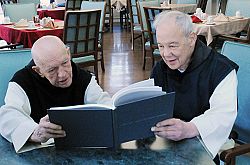Utah's former Trappist monastery is focus of movie, book

SALT LAKE CITY - The ending chapters of the Monastery of Our Lady of the Holy Trinity in Huntsville, which closed in 2017, are being preserved in a new book and an upcoming documentary film.
The monks, members of the Trappist order, came to Utah from Kentucky and built the monastery in Huntsville in 1947. For a time, the community thrived, but over the years vocations died out and the once 84-strong body of monks dwindled to just six. In 2014, the Order of Cistercians of the Strict Observance decided to close the monastery. In 2017, the remaining monks, who were in their 80s and 90s, went to live in a Salt Lake City senior living facility.
John Slattery, a California filmmaker, photographer and former Weber State University student, first visited the monastery in 2002. Struck by the beauty of its setting, the next year he began photographing the monastery and the monks, returning every year for 15 years, varying the times when he visited so he would capture the community during the different seasons. Slattery was the only filmmaker allowed such access.
“I think I knew there was something here when I started; it had no timeline,” he said.
Slattery said he first envisioned the project taking two or three years, but it kept evolving.
“At first I had no interest in the history of the monastery; I would just film, trying to capture the experience of being there,” he said. “But each time I came back the story changed. At some point I wondered if I should include some of what was happening there.”
Described as a “poetic-historical film,” “Present Time: Journal of a Country Monastery” chronicles this unique chapter in Utah history, in particular the last 15 years of the only men’s monastery ever to have existed in this community, where the dominant religion is The Church of Jesus Christ of Latter-day Saints.
The film will be released in the spring. The Utah Mountain Arts & Music Festival will host two screenings, April 19 and April 20 at the Compass Road Lodge in Huntsville. (Visit mountainartsandmusic@gmail.com for tickets). Slattery also plans screenings at Utah State University and in Salt Lake City this summer and fall.
Meanwhile, Slattery has released a coffee table book with the same name about the monastery. Toward the end of the course of his filming, he was given more than 2,000 photos taken by visitors that the monks had archived. He has restored many of them and published a number of them in a limited edition book.
“I went with the photos I thought were the most stunning,” Slattery said.
While proceeds from the book were meant to help fund final work on the film, it in itself is an important piece of work, capturing much of the life of the first 20 or so years of the community, Slattery said.
Two of the remaining monks, Father Patrick Boyle and Father David Altmann, recently took a look at a copy of the book.
“It is very well-done” and brings back many memories, Fr. Patrick said.
“It was a different world then,” Fr. David said of the time caught in the pages of the book.
The busiest time at the monastery was shortly after it opened, just after the end of WWII, as war-weary soldiers thought they had found a vocation there, only to discover that was not the case.
“They came in bus loads and they left in bus loads,” Fr. David said.
Fr. David, a Jewish convert to Catholicism, said he himself had a difficult time adjusting to life at the monastery at first.
“It was like walking into the Middle Ages, the lockstep lifestyle,” he said. “Over a period of time I realized I was content and fulfilled – that’s where your happiness is.”
The book, he said, gives a glimpse in a rough, historical way of the life in the monastery.
However, neither monk spends much time looking back.
For Fr. Patrick, the transition from the monastery to apartment living has been “a piece of cake,” he said.
“I believe in the sacrament of the now moment,” he said, referring to the practice of giving one’s life completely over to God.
“This is a new adventure for me, forward and up rather than back,” Fr. David said. “God has not called us to look at life through the rearview mirror.”
Recently, Fr. David returned to the monastery for a funeral and visited the old building.
“It was dark, empty and lifeless,” he said. “I realized we were the life in that place.”
It’s that life and its influence that Slattery has captured in the book and in the film. It was only as he started to wrap up his project that he began to understand the far-reaching impact of the monastery and its inhabitants, he said.
“So many people from around the world who visited the monks there have connected through the website,” he said. “Many of them are LDS people who grew up in the valley as kids. I did not realize how deep and broad the Utah connection is. There’s so much love for them here and internationally.”
Of “Present Time: Journal of a Country Monastery,” he said, “It’s a little movie about a little part of the world. “It’s a small film with a small but important audience.”
Both the book and the film give people an experience of a never-to-be-repeated era, now gone forever.
Information about the book and the film may be found at https://presenttimemovie.com.
© Copyright 2024 The Diocese of Salt Lake City. All rights reserved.

Stay Connected With Us